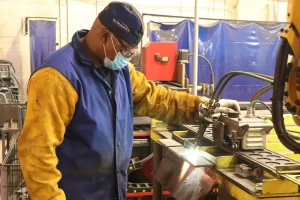Welding and fabrication are two words you probably hear a lot if you work in the metalworking sector. However, there is a clear distinction between fabrication and welding, even if the two terms are occasionally used synonymously. Between fabrication and welding, what is the difference? The best explanation is that welding is only one step in the fabrication process, whereas fabrication is the entire process of making metal.
Even though fabrication may incorporate welding, welding is always an element of fabrication. Metal components can be fabricated without welding, but if you’re doing it that way, your final product is unquestionably being fabricated. Various skill sets are utilized in the fabrication process and the welding trade. Both metal fabricators and welders are highly skilled artisans with frequently overlapping tasks in the broader metal manufacturing business.
Metal fabrication and welding are used to shape, cut, bend, and unite metal to manufacture various items. Various instruments and techniques are used throughout the process to reach the desired outcome.
Welding is a form of metal fabrication in which two metal components are welded together by pressure, heat, or both. Welders use specialized equipment to melt metal and create a connection to join two pieces together or fix cracks. As the metal cools, the connection typically solidifies fully. Below are descriptions of various jobs in welding.
As a gas metal arc welding method, MIG is also known. An electric arc is created by connecting with a metal workpiece while using a consumable MIG electrode. To melt and unite two metal parts, an electric arc produces heat.
Two pieces of metal are combined using this method using a non-consumable TIG electrode.
TIG and plasma arc welding are similar processes, but in plasma arc welding, the electrode is used in a torch, and the plasma arc can be isolated from the gas envelope.
Metal fabrication is the umbrella term for all operations using raw metal to create machines or buildings. The procedures include machining, burning, welding, cutting, shaping, and assembling. Sometimes, the entire manufacturing process is carried out in one location, while some businesses may hire other experts to handle certain activities, like welding.
It is possible to refer to a welding career as metal fabrication because it is a fabrication process. The majority of metal fabrication processes don’t use welding, though. The entire method of fabricating metal cannot be completed by a welder who simply uses welding-related instruments and techniques. Similarly, a metal fabrication shop without a welder cannot finish the welding portion of fabrication without the necessary equipment and expertise.
As you might know, welding entails joining two or more metal parts together. There are numerous distinct welding methods, and each has unique advantages and disadvantages. Gas tungsten arc welding, flux core arc welding, and gas metal arc welding are all common welding processes.
Ultimately, all welding processes aim to fuse various metal parts permanently. Contrarily, metal fabrication covers different metalworking techniques, including welding. Nonetheless, you need to view fabrication as more of an all-encompassing process.
Engineers must decide how to construct a specific building or component before beginning fabrication welding. In addition to cutting, machining, and shaping metal parts, designers also need to worry about things like layout creation. Fabricators typically employ various unique tools and methods to create a specific metal product.

The main areas of interest for craftspeople who identify as metal fabricators are metal cutting, machining, and bending. Metal sheets are frequently trimmed to the required size as the first step in the production process.
Mechanical saws, laser cutters, and plasma torches are a few cutting tools fabricators use to complete this operation. The metal is then partially removed, for example, by a fabricator using a lathe to provide holes for future bolts. Stretching and shearing equipment is then used to bend the metal, adding any required angles.
The tools used in the welding program, in comparison, are very different. They include consumable electrodes, welding clamps, torches, and power sources. The usage of special safety equipment is also necessary during welding. For example, welders are protected from harmful gases by respirators, while their eyes are shielded from ultraviolet radiation by auto-darkening welding helmets.
Tabletop equipment is typically used while fabricating metal. In other words, the welder fabricators near you attached the metal to the proper tool, then carefully manipulated the tool to do the required work. Different tactics are used in welding. Although stationary tools are necessary for welders, they often carry out the actual welding operation by hand.
Even though some fabricators are capable of welding, the complexity of the welding process frequently necessitates the use of more specialist professionals. A welder simply could not make solid or precise welds without putting in a lot of practice. Only a welder with extensive expertise can work with the required level of agility and competence while producing high-performance metal goods.
Read More